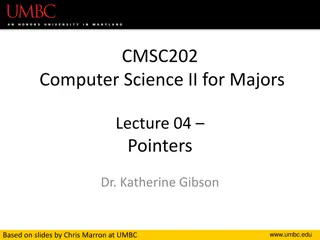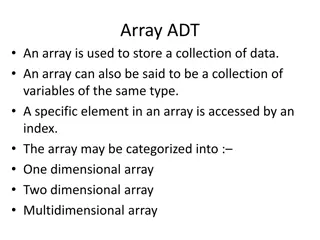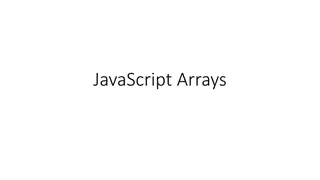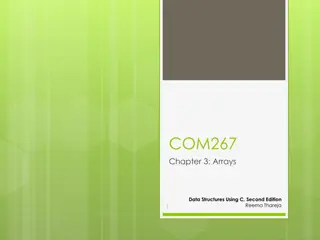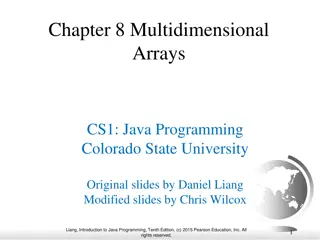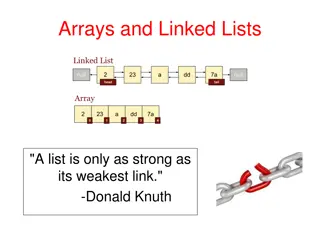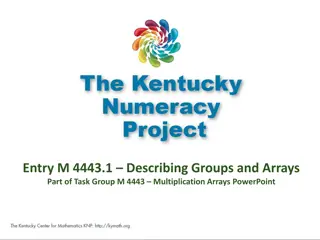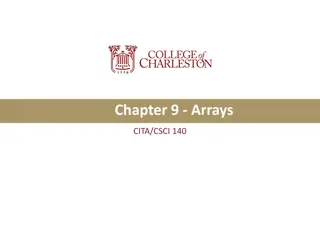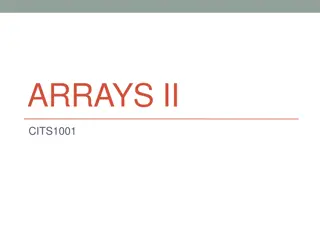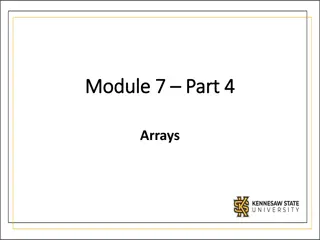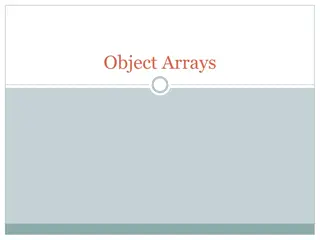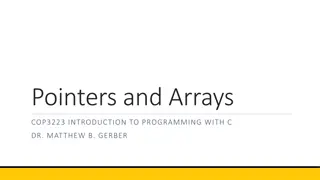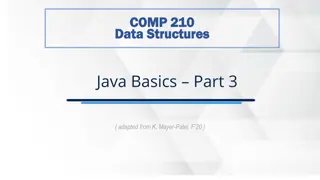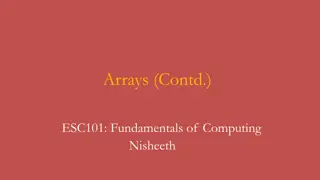Arrays as Pointers: Fundamentals of Computing
Explore the concept of using arrays as pointers in the context of computing. Learn how to create array of char pointers to store multiple strings, access elements in arrays of pointers, and understand the rules for accessing individual elements. Discover the nuances of pointer manipulation and array indexing, along with practical examples and insights into pointers to pointers. Dive into the fundamentals of computing through arrays as pointers.
Download Presentation

Please find below an Image/Link to download the presentation.
The content on the website is provided AS IS for your information and personal use only. It may not be sold, licensed, or shared on other websites without obtaining consent from the author.If you encounter any issues during the download, it is possible that the publisher has removed the file from their server.
You are allowed to download the files provided on this website for personal or commercial use, subject to the condition that they are used lawfully. All files are the property of their respective owners.
The content on the website is provided AS IS for your information and personal use only. It may not be sold, licensed, or shared on other websites without obtaining consent from the author.
E N D
Presentation Transcript
Arrays as pointers ESC101: Fundamentals of Computing Nisheeth
Can use array of char pointers to store many (i.e., an array of) strings Array of Pointers An array of (say char) pointers can be created in two ways Just like name of array is a pointer - Use a static array declaration char *ptrArr[3]; and then initialize each of the 3 pointers ptrArr[0], ptrArr[1], and ptrArr[2] using malloc or as static arrays Name of array of pointers is also a pointer of pointer - Use a dynamic array declaration as a pointer to pointers char **ptrArr = (char **)malloc(3*sizeof(char *)); and then initialize each of the 3 pointers ptrArr[0], ptrArr[1], and ptrArr[2] using malloc or as static arrays ESC101: Fundamentals of Computing
Array of Pointers Arrays of Arrays char **ptrArr = (char**)malloc(3*sizeof(char*)); for(i = 0; i < 3; i++) ptrArr[i] = (char*)malloc((i+1)*sizeof(char)); scanf("%c", &ptrArr[2][1]); printf("%c", ptrArr[2][1]); for(i = 0; i < 3; i++) free(ptrArr[i]); free(ptrArr); ptrArr[1] X ptrArr[0] ptrArr[0][0] ptrArr[1][0] ptrArr[1][1] ptrArr X X ptrArr[2] ptrArr[2][0] ESC101: Fundamentals of Computing ptrArr[2][1] ptrArr[2][2]
Accessing Elements in Array of Pointers/Arrays Rest assured, the same rules apply as do with pointers char *ptrArr[3], str[3]; for(i = 0; i < 3; i++) ptrArr[i] = (char*)malloc((i+1)*sizeof(char)); ptrArr[0], ptrArr[1], ptrArr[2] are all arrays of chars How to access individual elements of these arrays? Two ways to access index 2 element of str: str[2], *(str+2) Apply exact same rule : ptrArr[2][2], *(ptrArr[2]+2) both give index 2 element of the array ptrArr[2] Note that ptrArr[1] does not have 3 elements so ptrArr[1][2] may cause segfault! ESC101: Fundamentals of Computing
Dont write ptrArr++ illegal! Even str++ illegal! Accessing Elements in Array of Pointers/Arrays However, I can write char* qtr = str; qtr++; Now qtr points to str[1] I can also write char** rtr = ptrArr; rtr++; Now rtr points to ptrArr[1] Rest assured, the same rules apply as do with pointers char *ptrArr[3], str[3]; for(i = 0; i < 3; i++) ptrArr[i] = (char*)malloc((i+1)*sizeof(char)); Don t worry. we won t ask exam questions on int (*ptr)[5]; I will ask questions on pointers to pointers, array of pointers, etc though You can show-off your skills by cool array access tricks Remember that str is a pointer to str[0] In the same way, ptrArr is also a pointer to ptrArr[0] (which is an array) str + 2 gives address of str[2] ptrArr + 2 also gives address of ptrArr[2] (pointers take 8 bytes) same rules! We can access index 2 of the third array in many ways ptrArr[2][2],*(ptrArr[2] + 2),*(*(ptrArr + 2) + 2),(*(ptrArr+2))[2] Just one potentially confusing notation in C int *ptr[5]; is an array of 5 pointers to int but int (*ptr)[5] is a single pointer to an array of 5 ints ESC101: Fundamentals of Computing
2D Arrays: Revisited (Pointers view) int mat[3][5]; // note: 2D array name mat is also a pointer to pointer (int ** ) Declares a matrix (2D array) with 3 rows 5 columns Rows numbered 0, 1, 2. Columns numbered 0, 1, 2, 3, 4 Element at row-index i and column-index j is an int variable Can access it using several ways mat[i][j],*(mat[i] + j),*(*(mat + i) + j),(*(mat + i))[j] Careful! **(mat + i +j) *(*(mat + i) + j) *(*mat + i + j) Not that much actually let me show you the differences This looks exactly like the way we access an array of pointers/arrays what is the difference? ESC101: Fundamentals of Computing
2D arrays vs Array of pointers ARRAY OF POINTERS Different arrays can have different number of elements more flexibility Elements of a single array are contiguous but different arrays could be located far off in memory Have to be initialized element by element More power, responsibility 2D ARRAYS Number of elements in each row is the same All elements of 2D array are located contiguously in memory Easier to initialize int mat[3][5] = { {1,2}, {3}, {4,5,6},{7,8,9,10,11},{-1,2,3,4}}; Very convenient ESC101: Fundamentals of Computing
Memory layout of 2D arrays char str[3][4] = {"Hi","Ok","Bye"}; 000000 000001 000002 000003 000004 000005 000006 000007 000008 000009 000010 000011 000012 000013 000014 000015 000016 000017 000018 000019 000020 000021 000022 000023 str[0][0] str[0][1] str[0][2] str[0][3] str[1][0] str[1][1] str[1][2] str[1][3] str[2][0] str[2][1] str[2][2] str[2][3] H i Location of the str pointer not shown First all elements of row 0 stored in continuous sequence Then without breaking sequence, all elements of row 1 stored and so on char* ptr = *str; // ptr points to str[0][0] ptr += 4; // ptr now points to str[1][0] ptr += 4; // ptr now points to str[2][0] ptr += 1; // ptr now points to str[2][1] \0 \0 O k \0 \0 B y e \0 ESC101: Fundamentals of Computing
Layout of array of pointers char **str = (char**)malloc(3*sizeof(char*)); str[0] = (char*)malloc(4*sizeof(char)); str[1] = (char*)malloc(4*sizeof(char)); str[2] = (char*)malloc(4*sizeof(char)); 000000 000001 000002 000003 000004 000005 000006 000007 000008 000009 000010 000011 000012 000013 000014 000015 000016 000017 000018 000019 000020 000021 000022 000023 0 0 0 0 0 1 0 1 0 0 0 0 1 0 0 1 0 0 0 0 1 1 1 1 0 0 0 1 0 1 1 0 str str[0] str[1] str[2] str[0][0] str[0][1] str[0][2] str[0][3] Element within a single array always stored in sequence Different arrays may be stored far away from each other str[1][0] str[1][1] str[1][2] str[1][3] str[2][0] str[2][1] str[2][2] str[2][3] ESC101: Fundamentals of Computing
Summary Arrays are just an application of pointers In any dimensions, one can access arbitrary array elements with pointer math Dynamically allocated arrays of pointers are a much more general data structure Multidimensional arrays emerge as a special case Other data structures also emerge as special cases, as we will see when we discuss structures Whenever you get a problem where the size of the input arrays are not fixed, you have to use dynamic allocation ESC101: Fundamentals of Computing



